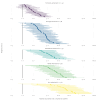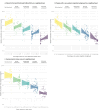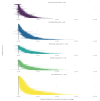Mobile vaccination units to increase COVID-19 vaccination uptake in areas with lower coverage: a within-neighbourhood analysis using national registration data, the Netherlands, September-December 2021
- PMID: 39176986
- PMCID: PMC11367067
- DOI: 10.2807/1560-7917.ES.2024.29.34.2300503
Mobile vaccination units to increase COVID-19 vaccination uptake in areas with lower coverage: a within-neighbourhood analysis using national registration data, the Netherlands, September-December 2021
Erratum in
-
Erratum for Euro Surveill. 2024;29(34).Euro Surveill. 2024 Aug;29(35):240829e. doi: 10.2807/1560-7917.ES.2024.29.35.240829e. Euro Surveill. 2024. PMID: 39212060 Free PMC article. No abstract available.
Abstract
BackgroundVaccine uptake differs between social groups. Mobile vaccination units (MV-units) were deployed in the Netherlands by municipal health services in neighbourhoods with low uptake of COVID-19 vaccines.AimWe aimed to evaluate the impact of MV-units on vaccine uptake in neighbourhoods with low vaccine uptake.MethodsWe used the Dutch national-level registry of COVID-19 vaccinations (CIMS) and MV-unit deployment registrations containing observations in 253 neighbourhoods where MV-units were deployed and 890 contiguous neighbourhoods (total observations: 88,543 neighbourhood-days). A negative binomial regression with neighbourhood-specific temporal effects using splines was used to study the effect.ResultsDuring deployment, the increase in daily vaccination rate in targeted neighbourhoods ranged from a factor 2.0 (95% confidence interval (CI): 1.8-2.2) in urbanised neighbourhoods to 14.5 (95% CI: 11.6-18.0) in rural neighbourhoods. The effects were larger in neighbourhoods with more voters for the Dutch conservative Reformed Christian party but smaller in neighbourhoods with a higher proportion of people with non-western migration backgrounds. The absolute increase in uptake over the complete intervention period ranged from 0.22 percentage points (95% CI: 0.18-0.26) in the most urbanised neighbourhoods to 0.33 percentage point (95% CI: 0.28-0.37) in rural neighbourhoods.ConclusionDeployment of MV-units increased daily vaccination rate, particularly in rural neighbourhoods, with longer travel distance to permanent vaccination locations. This public health intervention shows promise to reduce geographic and social health inequalities, but more proactive and long-term deployment is required to identify its potential to substantially contribute to overall vaccination rates at country level.
Keywords: Public health; effect evaluation; inequality; intervention; mobile vaccination units; vaccination.
Conflict of interest statement
Figures




References
MeSH terms
Substances
LinkOut - more resources
Full Text Sources
Medical
